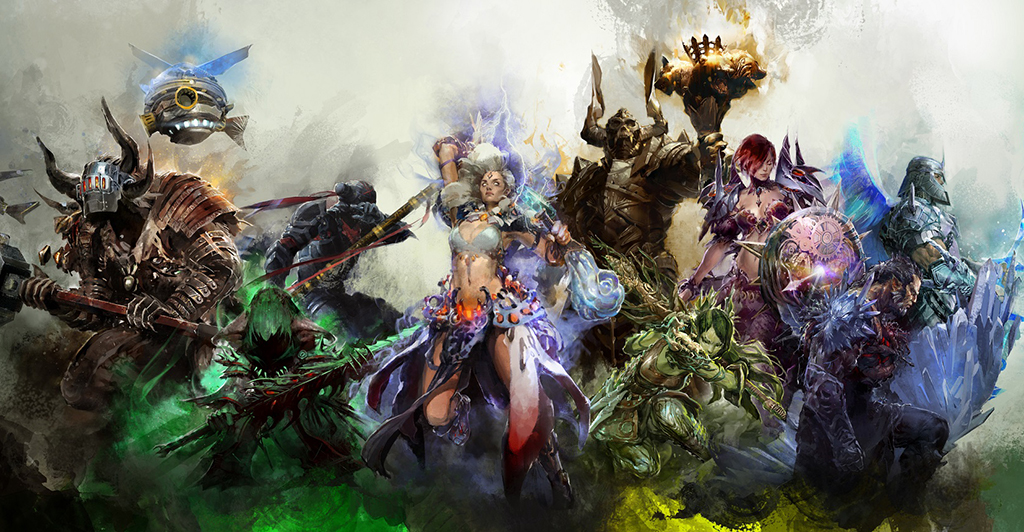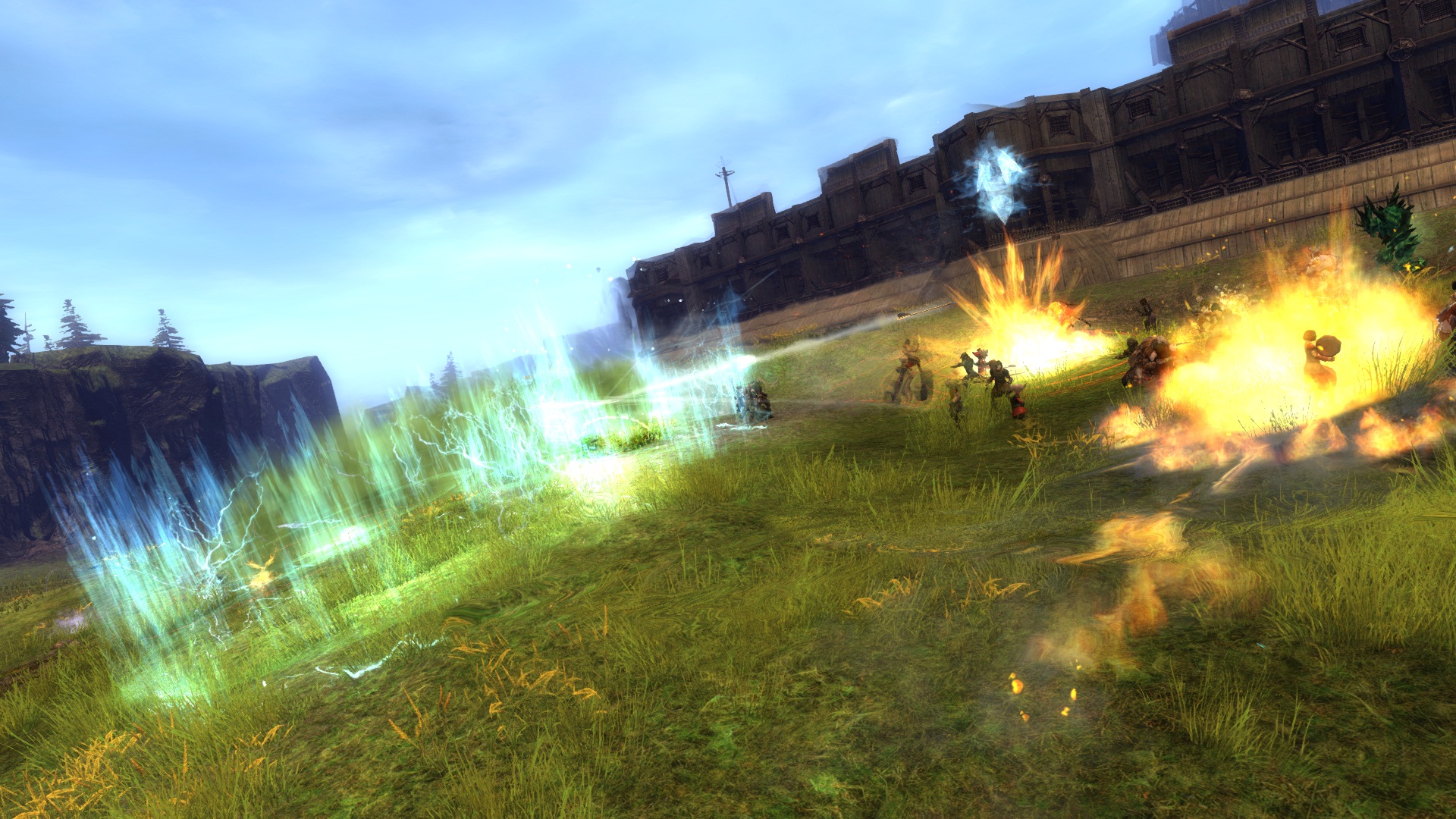5 Years and 10 Moments that changed Guild Wars 2

Dragons loiter overhead, gods quarrel, and the tides of devastation threaten to rip your world asunder, and you are busy farming precious leather. It’s just another day in any MMORPG. Five years after launch and Tyria has also endured its share of dragons, destruction, and drama. Before it all fades into a wistful memory or you simply get distracted by the daily gold farm, here are some of the most significant moments from the last five years of Guild Wars 2.
Announcing Guild Wars 2
2009, Cologne, Germany and Guild Wars 2 takes to the stage at Gamescom. Thousands of gamers snake through the gargantuan halls, packed with things to see and do. It might have been just another year at Europe’s biggest gaming event, but for fans of the original Guild Wars series it marked the dawn of a new era and a new future for Tyria. Martin Kerstein took to the stage in front of a heaving mass of appendages and unveiled Tyria, shiny, new, and at the heels of a monstrous dragon.
The Hunger Royale
Years of development, numerous conventions, a truckload of hype, and several beta tests later and Guild Wars 2 stepped up to showcase one last treat before the terror of Zhaitan became a reality. The Hunger Royale mini game has occurred just once in Tyria’s history and has never been seen since. In 2012, just before launch, scores of players were unleashed on the plains around Metrica Province as they slowly starved to death. Four teams of players waged a war of attrition against each other, foraging in the local undergrowth for food parcels to quench a hunger that ebbed away at their health. Compared to today’s Crab Toss or Dragon Bash, this might sound simple but booby trapped bundles, unique utilities, and a cool respawn mechanic that turned dead players into helper golems kept things sufficiently chaotic. The beta tests were also the first chance ArenaNet had to really let loose with the Guild Wars 2 engine and create something just for the heck of it. It was the first progenitor of some super adventures to come.
Super Adventure Box
What was to come next, of course, is an iconic update that landed in the main forecourt of Rata Sum on April 1, 2013. The brainchild of Josh Foreman, Environmental Artist at ArenaNet, the Super Adventure Box started life as an April fools update taking players on a whirlwind ride around an indulgent homage to retro platformers. Bright green pastures, rabbit tornadoes, agitated squirrels, and a princess in dire danger all deconstruct the established aesthetic that Art Director Daniel Dociu curated. It built a blisteringly bold world full of hard lines and sprightly critters that was a refreshing change to the impending doom that perpetually hangs over Tyria. Since its rapturous reception back in 2013, the Super Adventure Box has reappeared three additional times, with a Super Adventure Festival and Super Adventure Box: Back to School updates. It spawned a lego toy, its very own side game, innumerable gem store sales, and a trailer come TV commercial straight out of the eighties. It even incited player led protests when it repeatedly failed to reappear over subsequent years. Thankfully this absence proved to be temporary and these super adventures now remain a returning favorite for everyone in Tyria.
The Lost Shores
The Lost Shores update was one of ArenaNet’s first experiments with world changing events. A precursor to the ambitious Living World series, the Lost Shores introduced Southsun Cove. Initially a sun kissed holiday destination found idling in the Sea of Sorrows, it ruined the escapades of adventurous sun worshipers as the indigenous wildlife encroached on Tyrian settlements. The Karka, an aggressive purple crustacean, quickly became more than just an irritating pest. After some disturbances around Southsun Island, this escalated into a massive attack on the city of Lion’s Arch. A one time event chain occurred during the final weekend of The Lost Shores that found players fighting a gargantuan Ancient Karka. This represented a massive step-change in both the scale and difficulty of open world content in Tyria. No more centaurs trotting around Queensdale or collecting pearls for Quaggan. The Karka were the highest level adversaries yet to appear in Guild Wars 2 and the Ancient Karka kill involved innumerable players, pushing the game engine to it’s limits. Dispatching this infestation took hours. Particle effects flooded the island of Southsun and the game struggled to cope under the strain of so many participants.
You can still find the remnants of this Ancient Karka, twisted and charred in the lava pool at the bottom of the Karka Hive in Southsun Cove. The Lost Shores success may have been somewhat mixed, but it turned out to be a forerunner for even bigger world changing events. It also sowed the first seeds of Canach’s redemption and eventual rise to prominence during the Living World.
The First Ban Wave
In every MMORPG eventually the ban hammer comes down. People are fallible and whether it it the lure of a quick boost or something more insidious, cheating happens. Developers have to take action to keep things working as intended and at the end of August 2012, just weeks after Guild Wars 2 launched, the ban hammer was swiftly engaged. In a dramatic step, ArenaNet banned around 3000 player accounts across the game.
An unintended bug left tier 2 Norn weapons on sale, at a vendor in Ebonhawke, for the minuscule price of 21 Karma. In a time when Karma flowed like water, these weapons were subsequently reforged into a series of items or crafting components for a significant profit. While it didn’t seem like it had a crippling impact on the economy, it was significant for other reasons. Primarily, this was the first major ban wave for Guild Wars 2, it set the precedent on how ArenaNet would deal with large scale exploits, who it held responsible for using these bugs, and how it handled dissent in this sort of issue. If you missed the drama it still exists over on Reddit.
https://www.reddit.com/r/Guildwars2/comments/z44ml/karma_weapons_exploit/
Scarlet
One name is just as likely to strike glee into my heart as it is to spread fear across Tyria. Scarlet Briar, a gifted Sylvari with an inquisitive mind, first appeared during Living World Season 1. After crashing the Queen’s Jubilee celebrations in Divinity’s Reach, Scarlet proceeded to systematically wreak havoc across the land. Hijacking mechanical Watchknight guards, unleashing the Aetherblades, and forming the Toxic Alliance. After leaving utter devastation across Tyria Scarlet’s forces proceeded to up the ante even further by attacking Lion’s Arch and waking Mordremoth, the Jungle Dragon.
Waking Mordremoth kicked off the Heart of Thorns expansion and has had drastic implications for Tyria, but this is not why Scarlet Briar is so significant. Scarlet’s reign of terror changed the landscape of Tyria, the remnants of her marionette still linger in False River Valley and Kessex Hills is still a toxic mess. She was also the first true villain that the Pact Commander and assorted forces faced. While Scarlet was a maniacal genius, the Elder Dragons are a faceless force of nature. These prehistoric forces cannot be reasoned with, they do not have complex human motivations, and we cannot empathize with them at all. Scarlet was the first true face of evil that players faced and she was a gleeful diabolical master at it. We can only hope that in the future players might get to go back and experience Scarlet’s rise and fall first hand.
PVP The WTS Finals
While there are a number of potential game changing moments during PvP, from the launch of ESL sponsored streams to the recent addition of automated tournaments, it’s hard to overlook the importance of high profile competition. The first invitational PvP tournament final at Pax West 2013 proved that Guild Wars 2 could be competitive, but the World Tournament Series Finals elevated the public perception of Guild Wars 2 PvP outside the community.
https://www.flickr.com/photos/eslphotos/sets/72157656615778638/
Across 2014 and 2015, teams from China, North America, and Europe battled their way through regional qualifiers and on to three WTS finals in Beijing, Boston and Cologne. Coinciding with some of gaming’s biggest trade fairs, these finals played out in front of utterly massive audiences, both locally and on Twitch. Gamescom alone hosts hundreds of thousands of visitors.
Some of the Guild Wars 2 PvP scene’s biggest and brightest talents attended these finals which culminated 2015 at Gamescom. With $25,000 dollars on the line for the victors, and tens of thousands for the lower ranks, this was serious business. The WTS no longer runs but it legitimized Guild Wars 2’s PvP scene. Whether that is still the case with the loss of ESL partnership, is a question for the next 5 years.
The Manifesto
https://www.guildwars2.com/en/news/guild-wars-2-design-manifesto/
To players that followed Guild Wars 2 since its early conception, the manifesto represents the single defining moment in ArenaNet’s approach to play. Unveiled in April 2010, the Guild Wars 2 Design Manifesto set out ArenaNet’s philosophy to development. Mike O’Brien laid out ArenaNet’s plan to develop an MMORPG that was not simply crafted with the traditional market in mind, stating that “if you hate traditional MMORPGs, then you should really check out Guild Wars 2”. Guild Wars 2 was to be a game that dispatched the traditional gear grind for horizontal progression. It would make MMORPGs more social, allowing players to explore naturally and wield a new intuitive style of combat, as Colin Johanson explained when he swung his sword in front of Tyrians.
While it might not seem like it now, five years ago open world events, level scaling, dynamic combat, open mob tagging, event participation, and even ArenaNet’s inclusive approach to resurrection were all incredibly innovative. Guild Wars 2 broke down many of the barriers that closed off MMOs to so many, and inspired more than a few competitors to sit up and take notice.
Killing Culling in World vs World
For new players, unfamiliar with the endless hustle and bustle of conflict, the Mist Wars are a unique experience. Trundling down a ravine to find a wave of red wash towards you, particle effects flying in every direction, and destruction in its wake is a little overwhelming as you are unceremoniously roflstomped. Back in the annals of history WvW was not quite so colorful, draw distances could be described as near or “If I squint a bit harder I’ll be able to make out my fingers”, and lag doubled as an early warning system.
It’s fair to say that World vs World had a few problems on launch. Keeping everyone’s client’s up to date during large open combat scenarios has always been a problem for any game that has realm vs realm combat. Guild Wars 2 is no different. As large groups of players clashed in the Mist Wars, information spewed across ArenaNet’s network, reminding everyone on the battlefield that they were on fire, the Elementalist they were chasing was getting away, and their pet Moa had gone dawdling off after the wrong target. In order to reduce the load on everyone involved, culling happened. Culling limits the number of clients that could ever be reported to a player's computer. So, in order to increase performance, battles looked a little sparse.
During early 2013 one man almost single handedly solved this problem that had infested WvW. In a blog post Habib Loew, hailed by one member of ArenaNet as the wizard of WuvWuv, described the process of culling and how it would be largely resolved. While the limitations of technology cannot be circumvented, and players continue to test the limits of Guild Wars 2 in WvW, I can now see the whites of those little Asuran eyes as I dive right into battle!
[https://www.guildwars2.com/en/news/world-vs-worldthe-end-of-culling/
The Heart of Thorns Launch
The announcement of the Heart of Thorns expansion created huge levels of anticipation across Tyria. As the largest update that Guild Wars 2 had ever seen, the Maguma Jungle even dwarfed the gargantuan Silverwastes maps. A new dragon, special skills, challenges, gear, and an additional profession are just some of the features added to the base game. The Seattle studio poured vast effort into creating a massive environment containing a ton of vertical content, lots of new skills to learn, very aggressive enemies, and map wide meta events.
In the end though, Heart of Thorns is less significant for each of these updates as it is for its reception. A significant uptick in content difficulty, a move away from traditional heart based events, content gating, and a creeping sense that the grind was setting in resulted in a fairly lukewarm reception from some sections of the fan-base. Do not misunderstand, Heart of Thorns was a success, but not to the extent predicted by analysts. The massive jump in direction did not sit well with all of the community with lessons to come from this.
After the Path of Fire expansion preview in August 2017, and a shift back towards more approachable content, it is clear that Path of Fire will bring huge changes to Tyria. Will there be five more years of Guild Wars 2 and what will they bring? Will Mike O’Brien steer Guild Wars 2 back towards steadier waters? We will have to wait and see.
About Guild Wars 2
Guild Wars 2 is an online role-playing game with fast-paced action combat, a rich and detailed universe of stories, awe-inspiring landscapes to explore, two challenging player vs. player modes—and no subscription fees!



